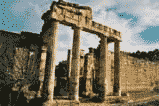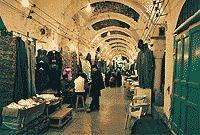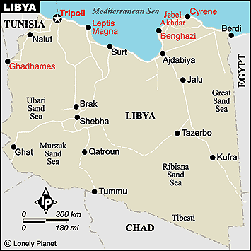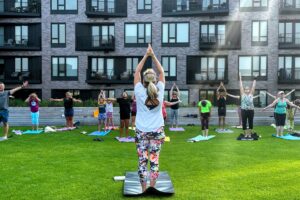By Jono David

In August 2001, I traveled behind enemy lines. Well, some US administrations would have you think so, anyway. But I viewed Libya with less suspicion.
I knew that its rich Roman and Greek heritage held great travel promise. I also knew that Libya on the ground would be, like most hot-spots in the world, far less dangerous than on TV.
Now, in light of Muammar Qaddafi’s WMD confessions and promises to disarm, even US lawmakers have softened their stance against the Mad Dog (as Qaddafi was once called). Americans are, for the first time since 1981, legally permitted to travel to the North African state.
Many Westerners will continue to view Libya with suspicion, however. Long synonymous with sponsored state terrorism or, at best, a useless desert, Libya means “dripping rain”, taken from Greek mythology. A visit here means seeing some of the most significant and best persevered Roman and Greek ruins in the Mediterranean, gracious hospitality bestowed by an affable people, and safe (yes, safe!), unfettered tourism.
“Welcome to Libya”
My 15-day tour included an air-conditioned mini-bus, three star hotels with breakfast, entrance fees, and our guide, Jamal al-Sager. We were also accompanied by Mahjdi, a guide-in-training; Khairi, our driver; and Mahmoud, our personal policemen, or minder. They took great care of us and often spoke candidly and with fondness about their little-known country.
My British Airways flight from London to Tripoli swooped in over the fertile north coast. In the immigration hall, beneath a banner calling for “Partners, not Wage Workers,” Jamal greeted me and the other nine British members of the group.
“Welcome to Libya,” he said through a tobacco-stained smile.
His greeting quickly became commonplace. Not only hotel personnel or restaurant staff seemed pleased to see us, but everyone in the streets, markets, cafes, and tourist sights.
“People are very nice here,” asserted Jamal in fluent English. “If you smile, they will smile back. And if they can speak some English, they will want to talk to you.”
No Flood of Tourism Yet
There is a hardly a tourist rush to this desert land three times bigger than France. But since UN sanctions were lifted in 1999, numerous European airlines have been ferrying in most of Libya’s 100,000 annual sightseers. The majority of them come on a package tour like me. Independent travel is permitted here but difficult if one does not speak Arabic.
After settling into a modern, sea-side high rise hotel, I set out with my roommate into Tripoli’s busy streets. Our first encounter with a local was a kind of moment of truth. British by birth but American by upbringing, I was hesitant about broadcasting my US citizenship. The US government still imposed its own sanctions on Libya, after all.
“I’m from America,” I said to the young man. I was pleased, if relieved, when he declared, “You are very welcome to Libya.”
Every one of our hellos was reciprocated. We walked, albeit quickly, round a meat market, and lingered in shops not unlike I do at home. I was surprised to see mini-skirts for sale. They hung like flags of Westernism. I didn’t see any women wearing one, however.
“Men are lucky,” said a shopkeeper at the Burj al Fatih tower, the tallest building in Libya. “We wear what we want. But women must be more careful or they have unwanted attention.”
No Burkas in Sight
Most women here wear shapeless, simple outfits and the hijab, a head scarf that many believe is a Koran directive. But Libyan women are not obliged to cover their faces nor to be a hidden part of society. In fact, Muammar Qaddafi advocates women’s rights, encouraging participation and education at all levels. But traditional Islamic values are hard to change, even for the nation’s leader.
Tripoli, the nation’s de facto capital, is a 3,000-year-old riddle. Phoenicians, Romans, Arabs, Ottomans, Spaniards, and Italians all left their marks, particularly the latter, whose wonderful architecture merges with a modern bland. But things are looking up. High rise offices and apartment buildings are giving the place a 21st century feel and an entrepreneurial image. That’s hardly the sort of city I expected to see.

Today, most visitors stop only long enough to be briefed on the nation’s history at the Jamahiriya Museum and to take a night’s lodging at both ends of a tour. But I liked the place for its wide streets and timeworn 1930s urbanity, its hospitable air and quaint though much neglected Medina (Old City). Above all, I liked being left alone.
No Hassles and Cheats
Unlike most other North African destinations, Libya’s streets and souqs (markets) are free of the tedious hassles and cheats which incense travellers. Maybe it is because Libyans don’t feel the economic need. Under law citizens are guaranteed certain state supports, such as pensions, healthcare, and housing.
Most Libyans live modest though comfortable lives in modern apartment blocks complete with satellite TV. My 45-year-old guide described the tube as a “Libyans’ eye on the world.” They watch CNN, BBC, and Discovery channel. A growing number of people even have internet. But not all changes are welcomed.
“Libyans are a small, peaceful people,” said Jamal, who tasted all the mod-cons during a two year stay in the USA.” We have traditional ways. We don’t want the fast American life where you know your neighbor’s name from the mailbox only.”

Perhaps more of a concern for Libya’s 5.5 million souls are the thousands of migrant workers in the country, many of whom are here illegally. From Sudan to Nigeria, these economic nomads come seeking better wages by doing the chores that Libyans simply don’t want to do.
One glimpse at the nation’s tangled historical diary proves these people are following a well-beaten path to economic gain. It’s a road that leads back three millennia.
The Phoenicians Came First
The Phoenicians were the first to arrive, establishing mineral, foodstuffs, and slave trading posts along the coast. The Carthaginians displaced them six centuries later but were defeated by the Romans in the 2nd century BC. The Greeks sneaked in from Egypt to the east a few hundred years earlier.
All left a great legacy of civilisation, thirst for economic might, and marvellous architecture.
It is their trail of ruins that most tours follow. Arguably the most significant invasion was in the 7th century AD when the Arabs brought Islam. Their gospel remains firmly rooted to this day in virtually every aspect of Libyan life. But Turks conquered the country in 1551 and Libya became an outpost of the Ottoman empire.
Italy annexed the nation in 1911 and made it a colony two decades later. Libyans suffered heavy casualties, thousands to bullets, others to exile. But many returned, notably members of the fiercely nationalistic Sanusi sect, to fight on the side of the Allies in World War II. By 1951, the United Kingdom of Libya became an independent country.
As the new nation’s first leader, King Idris I would never have a successor. Despite the formation of a national assembly and a constitution, there was virtually no ministerial leadership and little contact between parliament and his cabinet. With one of the lowest per capita GDP’s in the world, the flow of oil in 1959 appeased but did not extinguish civil disquiet.
Though housing expanded, education improved, and a health care system was implemented, corruption and Egyptian-influenced Arab nationalism inspired a band of army officers to take matters into their own hands on September 1, 1969. The White (bloodless) Revolution deposed the king, and four months later Muammar al-Qaddafi emerged as the country’s new leader.
Citizens of the new Libyan Arab Republic welcomed him as a strong nationalist leader committed to sharing the nation’s wealth. Blatantly anti-Western, he immediately put a squeeze on foreign investment, nationalised virtually everything, and made Arabic the official language.
Quaddafi’s Green Book
In his Green Book, Qaddafi sets out his Third Universal Theory of and socialism together on the premise that democracy and communism are unworkable systems. Instead, people’s committees in the four districts of Tripolitania, Benghazi (a.k.a. Cyrenaica), Fezzan, and Al Khalu report annually to the General People’s Congress (parliament) headed by Qaddafi in the self-appointed position of qa’id, meaning guide. In 1977, he redubbed the country to its present-day name, the Socialist People’s Libyan Arab Jamahiriya (state of the masses). In practice, however, leadership remains as it started: a military dictatorship.

Leaving Tripoli for the ancient Carthaginian trading post of Sabratha, I looked out from our air-conditioned bus into Qaddafi’s ubiquitous visage posted up on a large billboard. Later, when I walked in the long shadows of the site’s marble columns and cobbled avenues, I forgot that I was behind enemy lines.
Sabratha was an important trans-Saharan port. It was a permanent Roman city complete with temples, baths, a basilica, and the largest theatre in Roman Africa. Today, thanks largely to British and Italian restoration efforts, a
visit hardly feels 2,500 years removed from its foundation.
In every classical site we visited, from 7th century BC Greek Cyrene and Apollonia to 5th century BC Phoenician-Roman Leptis Magna, an ancient presence was our guide. Details demonstrated that the erstwhile residents
were more than rogue settlers. They were sophisticated, clever-minded people who enjoyed the best things in life from plumbing to theatre, from good roads to temples. I like those same things.
Seeing the Leptis Magna Ruins
For its imperial glory and town planning, including the largest baths outside Rome, Leptis Magna was declared a UNESCO World Heritage Site in 1982. Established to secure the eastern border in the face of Greek expansion, the city came under Roman control in the 2nd century BC. Prosperity peaked under the rule of Emperor Septimus Severus four hundred years later. But an earthquake in 306 AD devastated the city and its fate was sealed in the mid-400s when vandals invaded.
Not all of Libya’s pearls are strung out along its turquoise coastline. We chased a levitating horizon for 640 kilometres (397 miles) to the oasis town of Ghadhames, formerly an important rest stop on the trans-Saharan caravan routes. Noted for its uniquely adapted desert architecture, we hurriedly made our way from a blistering 43 degrees Celsius (110 F) to the shaded, chilled alleyways of the uninhabited old town.
Stepping inside the Cool Old Town
Stepping inside was like falling into a cold pool. The relief instantly demonstrated the architecture¹s ingenuity. We ferreted the labyrinths white-washed tunnel-like lanes to serendipity. Our way to courtyards and houses was lit by flashilghts and occasional open roof sky lights.
We passed through a green door (a common sight representing the color of Islam and the national flag), and emerged in a richly ornamented living room. Hand-painted walls and sumptuous cushions invited us to envision life here. A woman’s domain was upstairs and in the rooftop kitchen. From this vantage point, the town looked like an edible gingerbread fantasy.
Ghadhames also gave us a taste of the Sahara’s mesmerising sands. Before making our way cross country, we scampered up dusk-drenched dunes for a glimpse of the Algerian and Tunisian frontiers to the west.
Our 1,500 kilometre (930 mile) drive to the eastern Benghazi province was punctuated by intriguing little stops, including slumber in Syrte, Libya’s much avoided official administrative centre. An oil press here, a granary
there, museums and lunch stops kept us not only awake, but informed.
Check points also perforated the monotony of the open black top but only a handful of times did we come to a complete stop. At one such inspection in no place in particular, driver Khairi handed over official documents but not before he and a guard exchanged four kisses. I thought that was terrific. They bandied some happy words and we were on our way.
Time and again, we spied camel farmers and their flocks. We drove by expired automobiles, their rusty carcasses piled up in tidy pens. We slipped past forsaken old towns crumbling adjacent to neatly maintained new towns. They stand (and fall) like beacons of oil wealth. So do the pipelines of one of Qaddafi¹s most ambitious civil projects.
The Great Manmade River
The Great Manmade River (GMR) is a US$27 billion project designed to bring water from ancient desert aquifers to thirsty farmland and coastal cities hundreds of kilometres away. There are also plans to build a 3,000-kilometre (1,860 mile) rail network designed to link urban centres. Both endeavors match the boldness of those ancient ruins we had seen.
To reach Al Bayda, a non-descript town conveniently situated for visits to nearby Cyrene and Apollonia, we ascended the Green Mountains. Suddenly feeling as if we were on some patch of Italian plain, cooler temperatures and lush, red-soiled landscapes provided fertile relief from the arid humdrum elsewhere.
The town itself offered little beyond a night’s rest though I was pleased to find an internet shop. A Friday evening’s stroll round the centre revealed an amiable quality to the place. Men heeded calls to prayer whilst women leisurely window-shopped. I liked that.
Graves of 27,000 dead
From here we reached Tobruk for sobering lessons about World War II and perhaps one of Libya’s most important, if not, meaningful, destinations. Supremacy of the eastern Libyan, western Egyptian desert area was hotly contested. The Allied forces lost 27,000 soldiers in their efforts. Today, four crisply maintained cemeteries safeguard the memories of numerous nationalities and their religions. But the sight of Jewish graves in Libya was most unanticipated.
By the time we reached the vibrant commercial city of Benghazi the journey had been highlighted by numerous impressive and truthful moments. Many of them were had round the dinner table, exchanging ideas and impressions about Libya’s role in the world. At one such dinner, I took the opportunity to ask what Jamal wants for the future.
“I want less bureaucracy and more freedom to travel outside Libya,” he said without hesitation. “When you hold up your passport, it says, ‘British.’
When I hold up mine, it says, ‘terrorist.’ This is not right.”
I agreed. And for a moment, I thought that behind enemy lines was a place called home.

Libya Travel Details
WHEN TO GO: Libya is mostly a desert country and therefore one should be prepared for high temperatures, particularly inland. The coastal areas can be equally hot and occasionally muggy.
The overall best time to visit Libya is between November and March when daytime temperatures are relatively cool (30s Celsius/90s F). April to September can be brutal with temperatures easily pushing 40 Celsius (104 F) on the coast and 45-50 Celsius (113-122 F) in other areas.
WHAT TO BRING: Be prepared for intense, bright sun. Essential items include a wide-brimmed hat, sun glasses, sun screen (at least factor 15), and loose, lightweight, breatheable clothes with at least one pair of long trousers and long sleeved shirt (both for sun protection and possible cool evenings) Water bottles are a good idea but reliable, safe bottled water is widely available.
Money Money Money
MONEY: The currency of Libya is the Dinar (LD). The dinar is divided into 1000 dirhams. US$1=LD3.55 (September 2001). Dinars cannot be obtained e bought upon arrival in the airport. US Dollars or UK Pound Sterling cash is the best option. Travellers¹ Cheques are accepted but at a pathetic rate of exchange. Credit cards are very
rarely used. In the main cities, one can change money at one of the major banks. NOTE: Tourists may be told they are required to change US$ 500 upon arrival at the airport. Visitors on confirmed tours are usually exempted from this. However, leftover Libyan money can be sold back for US dollars upon departure. Be certain to retain all your exchange receipts.
TELEPHONE CODES: Country: 218; Tripoli: 021 (For all UK telephone numbers listed here: when dialing internationally to London, +44-20-number; when dialing from within the UK but outside London, 020-number; dialling within London, do not use the 020 code.)
VACCINATIONS: Libya is a fairly safe country in terms of health. There is low risk for malaria, hepatitis, and cholera. Recommended vaccinations: Diphtheria, Hepatitis A and B, Tetanus, Typhoid. NOTE: Plan injections early
as many cannot be administered together whilst others require 2 or 3 shot courses.
Tour Agencies Outside of Libya
TOUR AGENCIES: Most travellers visit Libya on a group tour booked by a company outside Libya. There are a surprising number of European-based companies who operate good tours usually from 7-15 days. Independent
travellers would be wise to have some sort of itinerary arranged upon arrival with the aid of a local agency, particularly if one does not speak Arabic.
* Tripoli-based: Wings Travel & Tours (the local representative for Explore Worldwide, listed below). Garanata Street, off Baladia Street near Green Square. Tel: 3331855, fax: 3330881, email: wingstravel@yahoo.com. They
specialise in classical sights but can also organise desert excursions.
* U.K.-based: I booked with Explore Worldwide: email tripinfo@exploreworldwide.com
WHERE TO STAY IN TRIPOLI:
If you are booked on a tour, your accommodations will already be secured for you. While hotel choices are relatively few across the country, for the most part, one will stay in adequate, if not surprising, comfort.
* Al Mehari: Shari’a Al Fatah. Large hotel overlooking the harbor. Tel: 3334090. Spacious rooms with TV, phone, and air conditioning. Pool, restaurant. Double: US$120;
* Bab Al Bahar Hotel: Al Kurnish Road (adjacent to Dhat al Imad Towers). Tel: 3350676, fax: 3350711.
A modern, 14-story building offering good value. Ample rooms with TV, phone, air conditioning, and good city or sea views. Restaurant.
Single/double: LD45/60, with continental breakfast.
WHERE TO EAT IN TRIPOLI:
If you are booked on a tour, meals may be included, particularly breakfast. Otherwise, tour guides often direct travelers to oft used restaurants by previous groups. Tripoli has a decent selection.
* Tripoli International Fair Restaurant: Omar Almukhtars Street. Tel: 4441418. Serves mixed grill and pasta. Daily, 11:00 a.m.-4:00 p.m. and 8:00 p.m.-midnight;
* Sofir Restaurant: Elbaladia Street behind the Grand Hotel. Tel: 4447064. Ambient Moroccan restaurant. Daily, 12:30 p.m.-4:00 p.m. and 7:00 p.m.-11:00 p.m. Friday, evenings only;
* Elburai Restaurant:
Tarig al Helga No. 38, Medina. Tel: 443556. Traditional, home-cooked Libyan food. Sat-Thurs, 11:30 a.m.-3:30 p.m. (lunch only). Reputedly Libya’s oldest restaurant run by Muneer Elburai.
VISAS: Libya welcomes applications for tourist visas from every nationality in the world. Every visitor to Libya requires a visa except for most people holding passports from Arab countries and Malta. Other visitors require an “invitation” which can be provided by Libyan tour operators.
Independent travelers are also welcome but should contact a Libyan-based travel agency for assistance. Either way, you will require an official translation of your passport into Arabic. In the U.K., this process may be done through: Travcour, Tempo House, 15 Falcon Road, Battersea, London SW11 2PJ. Tel: +44-020-7223-7662, email: travcour@cableinet.co.uk.
FOR US PASSPORT HOLDERS: Contact your travel agent. Also, see http://travel.state.gov for the most up-to-date government information.
* In the U.K., this process may be done through: Travcour. Tempo House, 15 Falcon Road, Battersea, London SW11 2PJ. Tel: +44-7223-5295; fax: 020-7738-2617, email: info@travcour.com.
The visa itself takes two weeks to issue after authorization from the Libyan Foreign Ministry, valid for three months from date of issue and good for one month’s stay. Travcour’s cost: UK£23.00 for the visa and a UK£25 service charge including the Arabic translation. Passport, one application form, and two photos (must not be the same photo as what is in the passport) required.
Also try the Libyan People’s Bureau (Embassy), 54 Ennismore Gardens, London SW7. Tel: +44-020-7589-6162.
GUIDEBOOKS: Libya Handbook by Footprint Publications (First edition, 2001) is the most complete guidebook available. Lonely Planet Publications has a Libya chapter in its North Africa book.
TOURIST INFORMATION: Libya has no official tourist offices. For information, see one of the guidebooks listed above, contact a European or local tour agency, or try the Libyan People’s Bureau (Embassy), 54 Ennismore Gardens, London SW7. Tel: +44-020-7589-6162.
On the internet: (recommended):
(others):
* cia.gov/cia/publications/factbook/geos/ly.html
* travel.state.gov
* lafa.org/aaljaran/
* lonelyplanet.com/destinations/africa/libya/printable.htm
Jono David writes from Osaka, Japan. Contact the author
- These 9 U.S. National Parks Require Reservations in 2024 - April 17, 2024
- Take a Hike in Olympic National Park - April 17, 2024
- The Wild Mississippi: 2340 Miles Across Ten States - April 8, 2024





